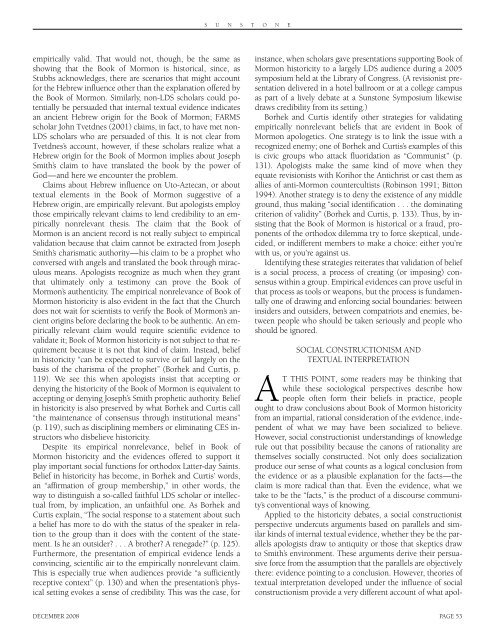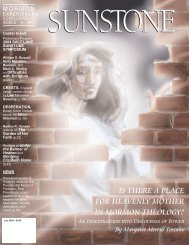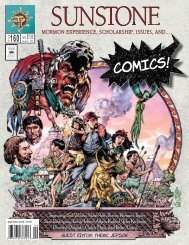Download Entire Issue PDF - Sunstone Magazine
Download Entire Issue PDF - Sunstone Magazine
Download Entire Issue PDF - Sunstone Magazine
You also want an ePaper? Increase the reach of your titles
YUMPU automatically turns print PDFs into web optimized ePapers that Google loves.
S U N S T O N E<br />
empirically valid. That would not, though, be the same as<br />
showing that the Book of Mormon is historical, since, as<br />
Stubbs acknowledges, there are scenarios that might account<br />
for the Hebrew influence other than the explanation offered by<br />
the Book of Mormon. Similarly, non-LDS scholars could potentially<br />
be persuaded that internal textual evidence indicates<br />
an ancient Hebrew origin for the Book of Mormon; FARMS<br />
scholar John Tvetdnes (2001) claims, in fact, to have met non-<br />
LDS scholars who are persuaded of this. It is not clear from<br />
Tvetdnes’s account, however, if these scholars realize what a<br />
Hebrew origin for the Book of Mormon implies about Joseph<br />
Smith’s claim to have translated the book by the power of<br />
God—and here we encounter the problem.<br />
Claims about Hebrew influence on Uto-Aztecan, or about<br />
textual elements in the Book of Mormon suggestive of a<br />
Hebrew origin, are empirically relevant. But apologists employ<br />
those empirically relevant claims to lend credibility to an empirically<br />
nonrelevant thesis. The claim that the Book of<br />
Mormon is an ancient record is not really subject to empirical<br />
validation because that claim cannot be extracted from Joseph<br />
Smith’s charismatic authority—his claim to be a prophet who<br />
conversed with angels and translated the book through miraculous<br />
means. Apologists recognize as much when they grant<br />
that ultimately only a testimony can prove the Book of<br />
Mormon’s authenticity. The empirical nonrelevance of Book of<br />
Mormon historicity is also evident in the fact that the Church<br />
does not wait for scientists to verify the Book of Mormon’s ancient<br />
origins before declaring the book to be authentic. An empirically<br />
relevant claim would require scientific evidence to<br />
validate it; Book of Mormon historicity is not subject to that requirement<br />
because it is not that kind of claim. Instead, belief<br />
in historicity “can be expected to survive or fail largely on the<br />
basis of the charisma of the prophet” (Borhek and Curtis, p.<br />
119). We see this when apologists insist that accepting or<br />
denying the historicity of the Book of Mormon is equivalent to<br />
accepting or denying Joseph’s Smith prophetic authority. Belief<br />
in historicity is also preserved by what Borhek and Curtis call<br />
“the maintenance of consensus through institutional means”<br />
(p. 119), such as disciplining members or eliminating CES instructors<br />
who disbelieve historicity.<br />
Despite its empirical nonrelevance, belief in Book of<br />
Mormon historicity and the evidences offered to support it<br />
play important social functions for orthodox Latter-day Saints.<br />
Belief in historicity has become, in Borhek and Curtis’ words,<br />
an “affirmation of group membership,” in other words, the<br />
way to distinguish a so-called faithful LDS scholar or intellectual<br />
from, by implication, an unfaithful one. As Borhek and<br />
Curtis explain, “The social response to a statement about such<br />
a belief has more to do with the status of the speaker in relation<br />
to the group than it does with the content of the statement.<br />
Is he an outsider? . . . A brother? A renegade?” (p. 125).<br />
Furthermore, the presentation of empirical evidence lends a<br />
convincing, scientific air to the empirically nonrelevant claim.<br />
This is especially true when audiences provide “a sufficiently<br />
receptive context” (p. 130) and when the presentation’s physical<br />
setting evokes a sense of credibility. This was the case, for<br />
instance, when scholars gave presentations supporting Book of<br />
Mormon historicity to a largely LDS audience during a 2005<br />
symposium held at the Library of Congress. (A revisionist presentation<br />
delivered in a hotel ballroom or at a college campus<br />
as part of a lively debate at a <strong>Sunstone</strong> Symposium likewise<br />
draws credibility from its setting.)<br />
Borhek and Curtis identify other strategies for validating<br />
empirically nonrelevant beliefs that are evident in Book of<br />
Mormon apologetics. One strategy is to link the issue with a<br />
recognized enemy; one of Borhek and Curtis’s examples of this<br />
is civic groups who attack fluoridation as “Communist” (p.<br />
131). Apologists make the same kind of move when they<br />
equate revisionists with Korihor the Antichrist or cast them as<br />
allies of anti-Mormon countercultists (Robinson 1991; Bitton<br />
1994). Another strategy is to deny the existence of any middle<br />
ground, thus making “social identification . . . the dominating<br />
criterion of validity” (Borhek and Curtis, p. 133). Thus, by insisting<br />
that the Book of Mormon is historical or a fraud, proponents<br />
of the orthodox dilemma try to force skeptical, undecided,<br />
or indifferent members to make a choice: either you’re<br />
with us, or you’re against us.<br />
Identifying these strategies reiterates that validation of belief<br />
is a social process, a process of creating (or imposing) consensus<br />
within a group. Empirical evidences can prove useful in<br />
that process as tools or weapons, but the process is fundamentally<br />
one of drawing and enforcing social boundaries: between<br />
insiders and outsiders, between compatriots and enemies, between<br />
people who should be taken seriously and people who<br />
should be ignored.<br />
SOCIAL CONSTRUCTIONISM AND<br />
TEXTUAL INTERPRETATION<br />
AT THIS POINT, some readers may be thinking that<br />
while these sociological perspectives describe how<br />
people often form their beliefs in practice, people<br />
ought to draw conclusions about Book of Mormon historicity<br />
from an impartial, rational consideration of the evidence, independent<br />
of what we may have been socialized to believe.<br />
However, social constructionist understandings of knowledge<br />
rule out that possibility because the canons of rationality are<br />
themselves socially constructed. Not only does socialization<br />
produce our sense of what counts as a logical conclusion from<br />
the evidence or as a plausible explanation for the facts—the<br />
claim is more radical than that. Even the evidence, what we<br />
take to be the “facts,” is the product of a discourse community’s<br />
conventional ways of knowing.<br />
Applied to the historicity debates, a social constructionist<br />
perspective undercuts arguments based on parallels and similar<br />
kinds of internal textual evidence, whether they be the parallels<br />
apologists draw to antiquity or those that skeptics draw<br />
to Smith’s environment. These arguments derive their persuasive<br />
force from the assumption that the parallels are objectively<br />
there: evidence pointing to a conclusion. However, theories of<br />
textual interpretation developed under the influence of social<br />
constructionism provide a very different account of what apol-<br />
DECEMBER 2008 PAGE 53

















